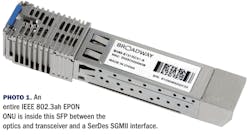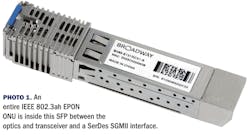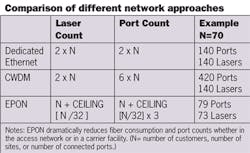SFP-based ONUs expand multipoint Ethernet market
By Victor Blake
Overview
Fiber access has been evolving at an ever increasing rate. Today FTTP technology has been so radically reduced in size and cost that an optical network unit (ONU) can be hidden within a modular transceiver.
Ethernet is the least common denominator of all wireline network services. Growing from its roots in data communications, Ethernet has become the ultimate de-facto network standard for all data (including Internet), voice, video, and now wireless backhaul.
With Ethernet as the basis for interoperability, the remaining challenge for network interoperability is media conversion from one Ethernet media to another (for example, 1000Base-TX to 1000Base-SX). The GigaBit Interface Converter (GBIC) was the first popular standard developed to package media conversion technology in a standard, modular, and user-serviceable form factor. Originally developed to provide multiple sources for transceivers and optics, multi-source agreements (MSAs) such as GBIC evolved to be media-independent Ethernet interfaces. While the IEEE continues to define the standards for Ethernet, the MSA interfaces (MII, GMII/SGMII) have become the new standard of Ethernet interoperability.
An MSA benefits platform vendors by insulating them from the risks of changes in media preferences. It allows them to market their products for new media types as they are developed and focus product development on core switching, routing, and service functions. For customers, the MSA provides flexibility for mixed-media requirements and a longer life for their capital investment in network equipment.
MSA packages have extended beyond the original purpose of multiple source specifications. Innovative products include XFP and XENPAK tunable transceivers, pseudowire emulation devices like TDMoverEthernet in an SFP, and most recently the SFP-ONU.
SFP-ONU
The SFP-ONU puts an EPON optical transceiver (PRX20), IEEE 802.3ah EPON ONU chip (most likely from Teknovus, which Broadcom recently purchased) and SerDes SGMII inside of an SFP (SFF8742). The photo shows an example from Broadway Networks (www.broadwaynetworks.com), which combines the company’s optics and an off-the-shelf Broadcom EPON chip in the SFP-ONU.
What that means for fiber to the premises (FTTP), and even for Ethernet more generally, is a radical change in the way that EPON technology can be used. The most obvious application for a PON is an outside plant distribution network such as used for FTTP. EPON is ideal for broadcast video, whether that be to a customer premises, to a cell tower, from a head end to hubs, or from a server to many switches or routers in a distribution network. This is because only PONs (and hybrid fiber/coax networks) support broadcast video operations. No other optical technologies (SONET, DWDM, CWDM, or baseband optical Ethernet) support native media broadcasting for IP multicast, as we’ll now discuss.
Broadcast and multicast on fiber
After years of development, IP multicast technology has finally paid off for service providers. Today multicast is used for IP video distribution by broadcasters, satellite-based service providers, cable multiple systems operators (MSOs), telcos, wireless operators, and in some content delivery networks (CDNs).
By using a logical IP tree approach, multicast allows the use of a single stream of content to serve many locations. The single stream is split to multiple streams only where the network physically separates to multiple paths. Today’s IP backbone networks (10-Gigabit Ethernet, 1-Gigabit Ethernet, and IP over SONET/SDH) use multicast, but require multiple source interfaces to service feeds going to different localities.
Although 1- and 10-Gigabit Ethernet support switching technologies (switches that support broadcast), backbone, regional, and some aggregation networks are built with point-to-point Ethernet. EPON and 10G-EPON offer the possibility of a single IP multicast source (a video server or a router interface) serving 32 splits in an outside plant network or even hundreds of splits in a backbone or regional data center, point of presence (POP), head-end, hub, central office, local switching office, etc.
For applications that distribute the same content to many subscribers (broadcast), PONs eliminate Ethernet switches and reduce fiber count in both distributed networks and inside carrier facilities. With the availability of 10G-EPON the economics are even more compelling.
A single EPON can (for example) replace a 33-port Ethernet switch and 32 router ports (by using only one EPON OLT port) distributing streaming video content. In the transport network between carrier facilities, the same PON could eliminate:
- 128 Gigabit Ethernet router ports,
- 128 DWDM transponder line cards or (or muxponder ports if muxed),
- a full DWDM system, and four strands of fiber,
and replace it with:
- two strands of fiber, each split to 32 sites in the outside plant (for a redundant PON equivalent to DWDM redundancy), and
- 64 EPON SFP-ONUs.
That eliminates an entire DWDM system, uses half as many fiber strands, and eliminates half of the router ports. The same thing could also be done with 10G-EPON for an even more dramatic equipment and cost reduction.
The earliest Ethernet technologies (10Base5 and 10Base2) were both multi-access. They supported broadcast transmissions (allowing one transmitter to communicate with multiple receivers simultaneously). Ironically this capability was a drawback in a largely unicast traffic environment like an enterprise LAN. The replacement of broadcast technologies with switched Ethernet enabled greater scaling and performance.
Today, 10-Gigabit Ethernet is characterized by only a switched point-to-point implementation. Broadcast technologies have all but disappeared. Multi-access optical networks, of which PONs are a subset, are the only high-performance (1 Gbps and now 10 Gbps) Ethernet technologies that support broadcast because they support multi-access.
Stop wasting fiber and ports
The three most appealing characteristics of PON technology are efficient use of fiber, broadcast and multicast support (multi-access optics), and low cost (because of these advantages and the high-volume manufacturing of relatively simple technology).
PON technologies use one strand of fiber and multiple splits (either localized or split at any point along a transmission network). The fiber split architecture enables operators to conserve fiber by using only one strand of glass to provide bi-directional access for one or more locations. At any location the network can be split into two or more branches.
EPON does not limit the split ratio to 32 or even 64 splits. In theory, EPON could support splits into the tens of thousands. The practical limit of splits is the optical power budget. In access networks, 32 or 64 splits would be typical. A network with shorter fiber lengths, such as a multiple-dwelling unit (MDU) deployment, could reasonably support 128 or possibly 256 splits. An office (premises wiring) implementation with EPON to the desktop could support 128, 256, or even higher splits. The same is true for a data center implementation.
Using one strand of glass in place of literally hundreds clearly conserves existing fiber infrastructure and reduces costs in any type of network.
CWDM is a low-cost fiber multiplexing approach that enables the sharing of two strands of fiber (one for each direction of transmission) among a small number of (8 to 10) endpoints. CWDM reduces fiber consumption when two strands of glass are available and the number of endpoints is small. The cost of CWDM is borne out with the complexity of point-to-point multiplexing, as shown in Figure 1. For each pair of endpoints (each Ethernet circuit) there may be six laser transmitters, six receivers, and six ports. The switch/router connection to the transponder could use 1000Base-TX, lowering the cost slightly, but the complexity and high port count remain the same.
Incorporating the CWDM optics into an SFP transceiver (but still using passive optical splitting and upcoming components not illustrated) reduces the complexity. Figure 2 shows the dramatic reduction in components (and therefore in cost) of a CWDM SFP-based approach. Such an option reduces the port and laser count to the same density as a baseband optical implementation.
EPON, like CWDM, first came to market as an external multiplexing technology as shown in Figure 3. The economic case for EPON optics (like the fiber consumption argument) is the use of one transmitter and one receiver for all 32 (or more) endpoints (on the OLT).
Like CWDM, EPON optics and now the EPON Layer 2 technology (the MAC plus 802.3ah protocol and operations, administration, and maintenance functions) are now available embedded within an SFP. With this technology, the port and laser cost for each endpoint is contained within a single SFP, as shown in Figure 4. The SFP reduces the component and port count and overall cost, just as in CWDM. The total cost of the system is driven by half as many ports and transceivers (up to the limit of the PON for 32, 64, or more endpoints).
Even without comparing the exact prices of components, the overall impact of this technology is evident in the volume reduction of components as shown in Table 1.
More to come
The innovation of the SFP-ONU combined with the economic benefits of fiber and the multi-access capabilities of EPON (for broadcast and multicast) make EPON a compelling technology not just for access networks, but for infrastructure IP and video distribution, for data centers, and for office or premise wiring. The economics are so compelling, we are sure to see new applications in control systems, vehicular implementations, and unanticipated environments.
Victor Blake is an independent consultant specializing in network strategies, architectures, and engineering (http://victorblake.com). He can be reached at [email protected].
Links to more information
Lightwave e-conference: The MSO FTTH Market Opportunity
Lightwave Online: IEEE SIEPON Standard to Tackle EPON Interoperability
Lightwave Online: IEEE Task Force Ratifies 10G EPON Standard






